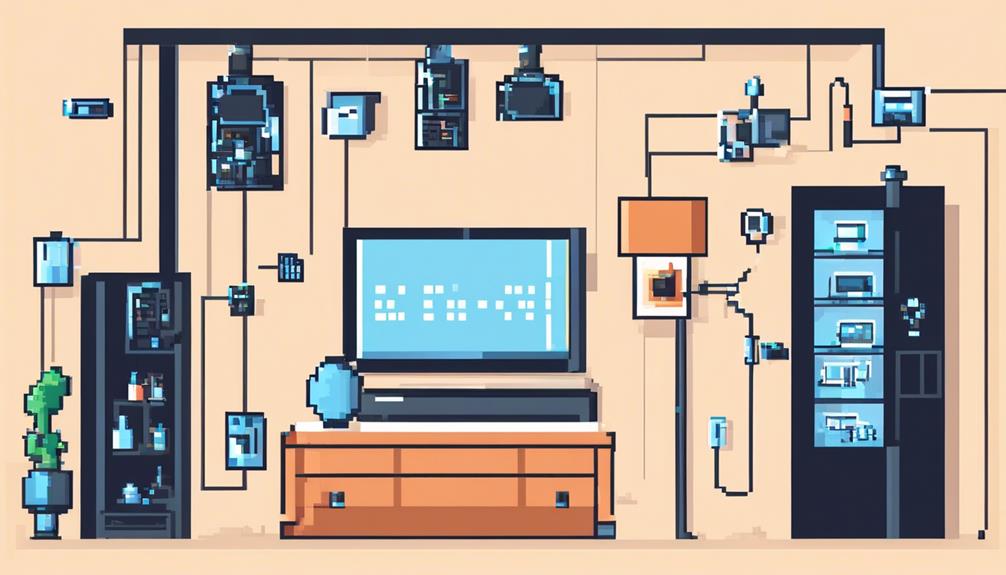As the demand for smart homes continues to rise, the role of edge computing hardware becomes increasingly significant. The complexity and interconnectivity of smart home systems necessitate hardware solutions that can efficiently process and analyze data in real-time.
Edge computing, with its ability to bring data processing closer to the source, offers reduced latency and improved response times, thus enhancing the overall performance of smart home devices.
Furthermore, edge computing enables seamless compatibility among different smart systems and devices from various manufacturers, addressing the interoperability challenges that often arise in this domain.
In this discussion, we will explore the basics of edge computing, its applications in smart homes, the hardware requirements, accelerators for improved performance, challenges related to interoperability and scalability, future trends, and the benefits of seamless integration with cloud computing.
So, let's dive into the world of edge computing hardware for smart homes and uncover the possibilities it holds for transforming our living spaces.
Key Takeaways
- Edge computing enables processing and analysis of data at the point of generation, reducing reliance on cloud processing and enhancing capabilities, response time, and device integration.
- Hardware requirements for edge computing in smart homes include powerful and efficient computing devices, low latency, sufficient storage capacity, robust security measures, interoperability, and advanced algorithms for accurate data analysis.
- Hardware accelerators like GPUs enhance processing capabilities, improve performance for computationally intensive tasks, enable faster data processing and analysis, and address limitations of accuracy, latency, and compatibility in smart home technology.
- Security and privacy considerations are crucial in smart homes, with robust security measures, encryption techniques, secure boot mechanisms, trusted execution environments (TEEs), and hardware-based security protecting sensitive data from unauthorized access and addressing privacy concerns.
Edge Computing Basics

Edge computing is a paradigm that enables processing and analysis of data at the point of generation, reducing the reliance on cloud processing and enhancing capabilities, response time, and device integration. In the context of smart homes, edge computing brings significant advancements to smart home devices, particularly in terms of processing power and data analysis. This technology has revolutionized the field of home security systems, allowing for more intelligent and accurate monitoring.
Edge computing hardware plays a crucial role in enabling the processing capabilities of edge devices. These devices are equipped with powerful processors and dedicated hardware that allow them to perform complex data processing tasks locally. This eliminates the need for data to be sent to the cloud for processing, thereby reducing latency and improving overall performance.
Smart home devices in a network are equipped with various sensors that collect data about the environment and user behavior. These sensors generate a massive amount of data that needs to be processed and analyzed in real-time. Edge computing technology enables this data processing to occur on the edge devices themselves, ensuring quick and efficient analysis.
Furthermore, edge computing technology allows for more intelligent data processing. For example, in home security systems, edge devices can differentiate between normal movements such as those caused by animals or leaves and suspicious activities that may indicate a potential threat. This level of intelligence is achieved by running advanced algorithms and machine learning models directly on the edge devices.
Smart Home Applications
Smart home applications encompass a diverse range of devices, including lighting, kitchen appliances, security systems, and more. Engineers working in this field face the challenge of developing intuitive and intelligent products that meet homeowners' expectations for faster response, higher performance, accuracy, and device integration. To address these requirements, the sensible use of sensors is crucial in smart home device design as it aids in accurate data collection and processing.
One of the key technologies that addresses the limitations of accuracy, latency, and compatibility in smart home technology is edge computing. By transferring processing and analysis to the device itself, edge computing allows for faster response times and reduced dependence on cloud-based solutions. This is especially important in scenarios where immediate action is required, such as in smart home security systems.
To enable edge computing in smart home applications, intelligent devices equipped with AI tools and sufficient processing power are essential. These devices can process data locally, reducing the need for constant communication with cloud servers. This not only improves response times but also enhances privacy and security by keeping sensitive data within the confines of the home.
One area where edge computing and AI have seen significant advancements is in computer vision. This technology allows smart home devices to analyze video feeds in real-time, enabling features such as facial recognition, object detection, and gesture control. By leveraging edge AI and local data processing, smart home devices can provide accurate and timely information to homeowners, enhancing the overall user experience.
Hardware Requirements

To enable effective edge computing in smart home applications, specific hardware requirements must be met. Edge computing involves transferring processing and analysis tasks from centralized systems to the devices themselves, allowing data processing to take place close to the sensor. This technology plays a crucial role in improving the accuracy of home security systems.
One of the key hardware requirements for edge computing in smart homes is the use of powerful and efficient computing devices. These devices need to be capable of processing and analyzing data in real-time, with low latency. They should also have sufficient storage capacity to handle the data generated by various sensors and devices within the home.
In addition to computing power, edge computing hardware must also prioritize security. Smart homes deal with sensitive data, including personal information and video feeds, which require robust security measures. Hardware components should include encryption capabilities and secure boot processes to protect data from unauthorized access.
Furthermore, edge computing hardware should be compatible with a wide range of smart home devices and systems. Interoperability is essential to ensure seamless integration and communication between different devices, enabling efficient data exchange and processing.
To differentiate between movements caused by animals and leaves, edge computing hardware needs to incorporate advanced algorithms and machine learning capabilities. These algorithms can analyze data in real-time to accurately identify and classify different objects or events.
Edge Servers and Local Processing
Local processing and edge servers play a critical role in bringing computation closer to the data source and enhancing the real-time capabilities of smart home devices. By processing data locally, these technologies enable quicker analysis and decision-making without relying on the cloud, resulting in improved responsiveness. Edge servers facilitate efficient processing of contextual data from sensors, enabling smarter and more accurate decision-making within smart home systems. This approach helps address compatibility challenges and reduces strain on network bandwidth in smart home environments.
The following table showcases the benefits of edge servers and local processing in the context of smart homes:
| Benefits of Edge Servers and Local Processing |
|---|
| Improved accuracy |
| Reduced latency |
| Enhanced compatibility |
| Increased functionality |
| Efficient data processing |
Edge computing and local processing provide better solutions for handling massive amounts of data generated by multiple smart systems in modern intelligent home technology. By bringing computation closer to the data source, these technologies enable efficient data processing and analysis, allowing for real-time decision-making. Furthermore, edge servers play a crucial role in supporting the integration of artificial intelligence tools within smart home systems, enhancing their capabilities.
Accelerators for Improved Performance

Edge computing hardware can leverage hardware accelerators, such as GPUs, to enhance processing capabilities and improve performance for computationally intensive tasks in smart home systems. These accelerators are specifically designed to offload intensive tasks from general-purpose processors, resulting in faster response times, smoother operations, and enhanced functionality for smart home devices.
One area where hardware accelerators play a crucial role is in AI and machine learning applications. With the increasing adoption of AI in smart homes, edge computing devices need to process large amounts of data and perform complex computations. Hardware accelerators like GPUs excel at parallel processing, allowing them to handle the high computational demands of AI algorithms. By utilizing these accelerators, smart home systems can collect data from multiple smart devices, process it using intelligence tools, and generate insights or make decisions based on the contextual data.
Furthermore, hardware accelerators address the limitations of accuracy, latency, and compatibility in smart home technology. The increased processing power provided by accelerators enables more accurate analysis and prediction, enhancing the overall intelligence of the system. Additionally, the improved performance leads to reduced latency, allowing smart home devices to respond quickly to user commands or changes in the environment.
Looking towards the future, specialized edge AI chips and hardware optimizations are emerging trends in edge computing hardware. These advancements promise even more powerful and energy-efficient components, further enhancing the performance and capabilities of smart home systems. By leveraging hardware accelerators, smart homes can continue to evolve and provide seamless experiences to users.
Security and Privacy Considerations
Security and privacy considerations are paramount in the realm of edge computing for smart homes, as protecting sensitive data is of utmost importance. With the increasing adoption of intelligent devices and multiple smart systems in homes, there is a growing need for robust security measures to ensure the confidentiality, integrity, and availability of data.
To address these concerns, edge computing hardware incorporates advanced security features that play a crucial role in safeguarding data security and privacy. Encryption techniques are employed to protect data from unauthorized access during transmission and storage. Additionally, secure boot mechanisms ensure the authenticity of the firmware and operating system, preventing tampering and unauthorized modifications.
Trusted Execution Environments (TEEs) provide secure environments for sensitive operations, isolating them from the rest of the system. This enhances security in edge computing by protecting critical data processing and analysis tasks from potential threats.
To provide a comprehensive understanding of the security and privacy considerations in edge computing for smart homes, the following table highlights key hardware-based security measures and their significance:
| Security Measure | Significance |
|---|---|
| Encryption | Protects data confidentiality during transmission and storage |
| Secure Boot Mechanisms | Ensures authenticity and integrity of firmware and operating system |
| Trusted Execution Environments (TEEs) | Provides secure environments for sensitive operations |
| Hardware-based Security | Protects data from unauthorized access and addresses privacy concerns |
These security measures not only protect the sensitive data collected from multiple sensors but also address privacy concerns that arise with the integration of technologies such as home security cameras. By implementing robust security features in edge computing hardware, smart homes can ensure that data processing and analysis are performed securely, mitigating potential risks and safeguarding the privacy of their residents.
Interoperability and Scalability Challenges

As smart home technology continues to advance and incorporate a diverse range of devices from different manufacturers, engineers face significant challenges in achieving interoperability and scalability. These challenges include the need to integrate widely varying intelligent devices into a cohesive ecosystem, enable multiple smart systems to work together seamlessly, and find innovative new approaches to improve accuracy and reduce latency.
To achieve interoperability, engineers must develop solutions that allow for the easier integration of multiple devices from different manufacturers. This requires standardized protocols and communication interfaces that enable seamless communication and data exchange between devices. By establishing common standards, engineers can ensure that devices from different manufacturers can work together without relying solely on proprietary technologies.
Scalability is another critical challenge in smart home technology. As the number of intelligent devices in a home increases, so does the complexity of managing and coordinating them. Engineers need to design systems that can handle the increased data processing and storage requirements that come with scaling up the number of devices. This involves developing hardware and software architectures that can support higher levels of performance and capacity.
Furthermore, improving the accuracy and reducing the latency of smart home systems is essential for providing real-time responses and effectively processing critical data. Engineers need to explore innovative approaches, such as edge computing, to address these challenges. By bringing processing and analysis closer to the source of data, edge computing can improve the responsiveness of smart home systems and reduce the latency associated with sending data to the cloud for processing.
Future Trends in Edge Computing Hardware
One emerging trend in edge computing hardware for smart homes is the integration of specialized chips designed to accelerate machine learning and AI workloads at the edge. These chips enable more efficient processing of data directly within smart home devices, eliminating the need for data to be sent to the cloud for analysis. This type of smart home computing helps alleviate latency issues and provides real-time responses, making it particularly suitable for applications that require high performance and quick decision-making.
Engineers must develop better solutions as soon as possible to handle the wide range of AI and machine learning tasks that are becoming integral to smart homes. The increasing amount of data generated by these devices, such as video feeds, sensor readings, and voice commands, necessitates powerful hardware components capable of handling complex computations.
Neuromorphic computing is another area that plays a vital role in the future of edge computing hardware for smart homes. These low-power, highly parallel computing capabilities enable edge devices to process data more efficiently while consuming minimal energy. This type of computing architecture offers better performance and energy efficiency, making it an ideal choice for smart home technology.
Furthermore, the adoption of ARM chips in various edge devices is a future trend in edge computing hardware for smart homes. ARM chips are known for their low power consumption and enhanced processing capabilities, making them suitable for edge computing applications. Their scalability and compatibility make them a preferred choice for smart home devices that require efficient, high-performance computing.
However, hardware standardization and interoperability pose challenges in the diverse landscape of edge computing. To address these challenges, engineers must focus on developing scalable and compatible hardware solutions that can seamlessly integrate with different smart home devices. Advancements in technology hold promise for more powerful and energy-efficient hardware components, offering potential solutions to scalability and interoperability challenges in edge computing for smart homes.
Benefits for Smart Home Devices

Edge computing offers numerous benefits for smart home devices. By enabling enhanced functionality and processing capabilities on the device itself, edge computing improves accuracy, reduces latency, and enhances compatibility.
Here are three major benefits of edge computing for smart home devices:
- Improved response time: With edge computing, smart home devices can process data locally, allowing for faster response times. This is particularly crucial for time-sensitive tasks such as voice commands or real-time monitoring. By reducing the reliance on cloud processing, edge computing ensures that smart home devices can quickly analyze data and provide timely responses to end users.
- Reduced data transmission: Edge computing allows smart home devices to process and analyze data locally, minimizing the need for data transmission to cloud servers. This not only reduces latency but also conserves bandwidth and reduces the cost of data transmission. By ignoring accurate but non-critical data, edge computing ensures that only relevant information is transmitted, optimizing the overall efficiency of the system.
- Seamless integration: Edge computing enables smart home devices to seamlessly integrate with other devices and systems in the home. With the ability to process data locally, smart home devices can communicate directly with each other, enabling real-time coordination and automation. This allows for a more efficient and cohesive smart home ecosystem.
Seamless Integration With Cloud Computing
Seamless integration with cloud computing facilitates efficient data transfer and processing between edge devices and the cloud, allowing for enhanced scalability and advanced processing capabilities. Edge devices, such as smart home devices, can seamlessly communicate with cloud services for various tasks, including data storage, analysis, and access to additional resources. This integration enables edge devices to leverage cloud-based machine learning and AI algorithms, enhancing their processing capabilities.
One of the advantages of edge computing is the ability to perform processing at the edge, closer to the data source, reducing latency and improving overall performance and functionality. However, there are limitations to edge devices, such as limited processing power and storage capacity. By seamlessly integrating with cloud computing, edge devices can offload resource-intensive tasks to the cloud, overcoming these limitations and achieving scalability.
In terms of data storage, cloud computing provides a secure and reliable solution. Storing sensitive information on edge devices may pose a risk of unauthorized access or data loss. With seamless integration, data can be securely stored in the cloud, ensuring data integrity and accessibility.
Additionally, seamless integration with the cloud enhances security and privacy. The cloud offers robust security measures, such as encryption and access controls, protecting data from unauthorized access. This is especially crucial when dealing with sensitive information in smart homes, where privacy is paramount.
To illustrate the advantages of seamless integration with cloud computing, consider the following table:
| Advantages of Edge Computing | Seamless Integration with Cloud Computing |
|---|---|
| Processing at the edge | Offloading resource-intensive tasks |
| Reduced latency | Improved scalability and flexibility |
| Security and privacy | Enhanced data storage and access control |
Frequently Asked Questions
What Hardware Is Used in Edge Computing?
Edge computing utilizes specialized hardware to bring data storage and computation closer to the data source. This reduces latency and enhances real-time capabilities for devices in various domains, including smart homes.
The hardware used in edge computing includes edge servers with localized processing, storage, and networking capabilities. Additionally, hardware accelerators like GPUs are employed for computationally intensive tasks. Security and privacy features, such as advanced encryption techniques, are crucial in edge computing hardware to safeguard sensitive data.
Future trends include specialized edge AI chips, neuromorphic computing, and low power consumption ARM chips.
What Are Smart Edge Devices?
Smart edge devices play a crucial role in enabling efficient and secure smart home automation. These devices offer numerous benefits, such as faster response times, improved reliability, and enhanced privacy. They find applications in various domains, including home security, energy management, and healthcare.
Artificial intelligence algorithms are employed to achieve higher accuracy and reduced latency through sensor fusion at the edge. Security considerations are of utmost importance to protect sensitive data. Integration with IoT systems and the challenges of implementation are key areas of focus.
Future developments aim to provide cost-effective solutions and leverage the potential of 5G technology to further enhance the capabilities of smart edge devices.
What Device Is Mostly Used in the Edge Network?
In the edge network, the device that is mostly used is the edge server. Edge servers provide localized processing, storage, and networking capabilities at the edge, acting as intermediary devices between edge devices and the cloud.
They play a crucial role in processing and analyzing data at the point of data generation.
The adoption of hardware accelerators like GPUs enhances the processing capabilities of edge servers, making them particularly beneficial for tasks such as machine learning and computer vision.
What Is Home Edge Computing?
Home edge computing refers to the processing and analyzing of data at the point of data generation in smart home devices. It offers several benefits, including improved accuracy, reduced latency, enhanced compatibility, and increased functionality.
Applications of home edge computing span across various sectors, including healthcare, where it can be used for remote patient monitoring. However, implementing home edge computing poses challenges such as limited computational resources and security considerations.
Artificial intelligence plays a crucial role in home edge computing, enabling intelligent decision-making.
In the future, home edge computing is expected to integrate more seamlessly with IoT devices and contribute to energy efficiency in smart homes.

